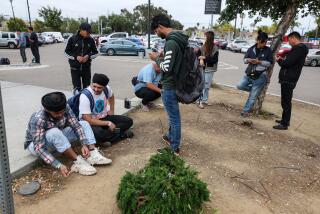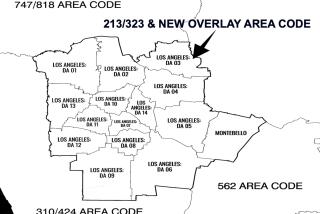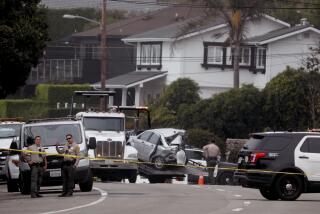Half of 310 Area Will Be Changed to 562 : Communications: Where the dividing line will be drawn hasn’t been determined. Action was taken because available numbers are running out, officials say.
If you live in the 310 area code, the odds are about even that you will have a new code by sometime in early 1997.
The state Public Utilities Commission on Friday rejected plans by GTE California and Pacific Bell for a new “overlay” code that would have been stacked atop the existing 310 to create a potentially confusing mix of the two in the same neighborhoods.
Instead, the PUC decided to split the existing code: Half will retain 310, the other half will get a brand-new code--562. The split will be geographical, but where the dividing line will be drawn is yet to be determined, according to PUC spokeswoman Kyle Devine.
“PacBell has until Aug. 21 to come up with a plan,” she said. “If they can’t, the PUC will determine it sometime next month.”
The decision to split rather than overlay was made to reduce confusion and “to make the playing field more level for all the phone companies,” PUC officials said.
They said an overlay would have forced customers of smaller companies, like MCI, to use a 10-digit number to make calls within the 310 area, while PacBell and GTE customers would have continued to use seven-digit local numbers. MCI, Sprint and others favored the split, but PacBell and GTE opposed it.
“We’re really disappointed,” Linda Bonniksen, a spokeswoman for PacBell said after the PUC’s decision in San Francisco.
“This will mean a number change for 2.4 million customers for the second time in less than five years, “ she said. “If we keep splitting the existing area codes, pretty soon there will be nothing left to split.”
A new area code is needed because the 310 area is running out of available numbers, officials said. The 818 area in the San Fernando and San Gabriel valleys is expected to run out soon, and Bonniksen said California probably will need nine new area codes by 2000.
The 562 area will make Los Angeles one of only four places in the country to have an area code without a middle digit of 0 or 1. The others are in Alabama, Washington state and Arizona.
As originally set up, the 0 or 1 in the middle of a three-digit area code signaled telephone-switching equipment that the number was an area code and not the first three digits of a local phone number. Such area codes limited the total of telephone numbers in the United States to about 1 billion.
The introduction of an 11th digit--a 1 preceding the three-digit area code and the seven-digit local number--made possible a wider variety of area code combinations. That change eventually will permit about 5 billion telephone numbers in the United States, officials say.
The current 310 area code is shaped much like “the smile of the Cheshire Cat,” in Devine’s words.
“It starts up around Malibu and Beverly Hills and curves down along the coast and around to Long Beach,” she said. “Then it curls back up again to Whittier and to La Habra in Orange County.”
More to Read
Sign up for Essential California
The most important California stories and recommendations in your inbox every morning.
You may occasionally receive promotional content from the Los Angeles Times.









